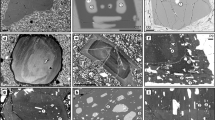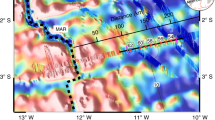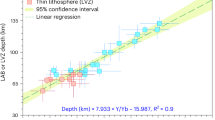Abstract
Mid-ocean ridge magmas are produced when Earth’s mantle rises beneath the ridge axis and melts owing to a decrease in pressure. This magma subsequently undergoes cooling and crystallization to form the oceanic crust. However, there is no consensus on where within the crust or upper mantle crystallization occurs1,2,3,4,5. Here we provide direct geochemical evidence for the depths of crystallization beneath ridge axes of two spreading centres located in the Pacific Ocean: the fast-spreading-rate East Pacific Rise and intermediate-spreading-rate Juan de Fuca Ridge. Specifically, we measure volatile concentrations in olivine-hosted melt inclusions to derive vapour-saturation pressures and to calculate crystallization depth. We also analyse the melt inclusions for major and trace element concentrations, allowing us to compare the distributions of crystallization and to track the evolution of the melt during ascent through the oceanic crust. We find that most crystallization occurs within a seismically imaged melt lens located in the shallow crust at both ridges, but over 25% of the melt inclusions have crystallization pressures consistent with formation in the lower oceanic crust. Furthermore, our results suggest that melts formed beneath the ridge axis can be efficiently mixed and undergo olivine crystallization in the mantle, before ascent into the ocean crust.
This is a preview of subscription content, access via your institution
Access options
Subscribe to this journal
Receive 12 print issues and online access
$259.00 per year
only $21.58 per issue
Buy this article
- Purchase on Springer Link
- Instant access to full article PDF
Prices may be subject to local taxes which are calculated during checkout




Similar content being viewed by others
References
Nicolas, A. & Reuber, I. A new magma chamber model based on structural studies in the Oman ophiolite. Tectonophysics 151, 87–105 (1988).
Quick, J. & Denlinger, R. Ductile deformation and the origin of layered gabbro in ophiolites. J. Geophys. Res. 98, 14015–14027 (1993).
Phipps Morgan, J. & Chen, Y. The genesis of oceanic crust: Magma injection, hydrothermal circulation, and crustal flow. J. Geophys. Res. 98, 6283–6297 (1993).
Kelemen, P., Koga, K. & Shimizu, N. Geochemistry of gabbro sills in the crust–mantle transition zone of the Oman ophiolite: Implications for the origin of the oceanic lower crust. Earth Planet. Sci. Lett. 146, 475–488 (1997).
Kelemen, P. & Aharonov, E. in Faulting and Magmatism at Mid-ocean Ridges Vol. 106 (eds Buck, W. R., Delaney, T., Karson, A. & Lagabrielle, Y.) 267–289 (1998).
Detrick, R. S. et al. Multi-channel seismic imaging of a crustal magma chamber along the East Pacific Rise. Nature 326, 35–41 (1987).
Kent, G., Harding, A. & Orcutt, J. Distribution of magma beneath the East Pacific Rise between the Clipperton transform and the 9 17’ N Deval from forward modeling of common depth point data. J. Geophys. Res. 98, 13945–13969 (1993).
Canales, J. P. et al. Upper crustal structure and axial topography at intermediate spreading ridges: Seismic constraints from the southern Juan de Fuca Ridge. J. Geophys. Res. 110, 1–27 (2005).
Johnson, K. T. M., Dick, H. J. B. & Shimizu, N. Melting in the oceanic upper mantle: An ion microprobe study of diopsides in abyssal peridotites. J. Geophys. Res. 95, 2661–2678 (1990).
O’Hara, M. & Mathews, R. Geochemical evolution in an advancing, periodically replenished, periodically tapped, continuously fractionated magma chamber. J. Geol. Soc. Lond. 138, 237–277 (1981).
Batiza, R. et al. Steady and non-steady state magma chambers below the East Pacific Rise. Geophys. Res. Lett. 23, 221–224 (1996).
Sinton, J. & Detrick, R. Mid-ocean ridge magma chambers. J. Geophys. Res. 97, 197–216 (1992).
Crawford, W., Webb, S. & Hildebrand, J. Constraints on melt in the lower crust and Moho at the East Pacific Rise, 9 deg 48 min N, using seafloor compliance measurements. J. Geophys. Res. 104, 2923–2939 (1999).
Dixon, J. E. & Stolper, E. M. An Experimental study of water and carbon dioxide solubilities in mid-ocean ridge basaltic liquids. Part II: Applications to degassing. J. Petrol. 36, 1633–1646 (1995).
Bottinga, Y. & Javoy, M. Mid-ocean ridge basalt degassing: Bubble nucleation. J. Geophys. Res. 95, 5125–5131 (1990).
Bottinga, Y. & Javoy, M. MORB degassing: Evolution of CO2 . Earth Planet. Sci. Lett. 95, 215–225 (1989).
Dixon, J., Stolper, E. & Delaney, J. R. Infrared spectroscopic measurements of CO2 and H2O in Juan de Fuca Ridge basaltic glasses. Earth Planet. Sci. Lett. 90, 87–104 (1988).
Le Roux, P., Shirey, S., Hauri, E., Perfit, M. & Bender, J. The effects of variable sources, processes and contaminants on the composition of northern EPR MORB (8–10° N and 12–14° N): Evidence from volatiles (H2O,CO2, S) and halogens (F, Cl). Earth Planet. Sci. Lett. 251, 209–231 (2006).
Soule, S. A. et al. CO2 variability in mid-ocean ridge basalts from syn-emplacement degassing: Constraints on eruption dynamics. Earth Planet. Sci. Lett. 327–328, 39–49 (2012).
Saal, A., Hauri, E., Langmuir, C. & Perfit, M. Vapour undersaturation in primitive mid-ocean-ridge basalt and the volatile content of Earth’s upper mantle. Nature 419, 451–455 (2002).
Shaw, A., Behn, M., Humphris, S., Sohn, R. & Gregg, P. Deep pooling of low degree melts and volatile fluxes at the 85° E segment of the Gakkel Ridge: Evidence from olivine-hosted melt inclusions and glasses. Earth Planet. Sci. Lett. 289, 311–322 (2010).
Rubin, K. & Sinton, J. Inferences on mid-ocean ridge thermal and magmatic structure from MORB compositions. Earth Planet. Sci. Lett. 260, 257–276 (2007).
Shimizu, N. The geochemistry of olivine-hosted melt inclusions in a FAMOUS basalt ALV519-4-1. Phys. Earth Planet. Int. 107, 183–201 (1998).
Dunn, R., Toomey, D. & Solomon, S. C. Three-dimensional seismic structure and physical properties of the crust and shallow mantle beneath the East Pacific Rise at 9 30′ N. J. Geophys. Res. 105, 23537–23555 (2000).
Nedimović, M. R. et al. Frozen magma lenses below the oceanic crust. Nature 436, 1149–1152 (2005).
Karson, J., Collins, J. & Casey, J. Geologic and seismic velocity structure of the crust mantle transition in the Bay of Islands ophiolite complex. J. Geophys. Res. 89, 6126–6138 (1984).
Klein, E. in The Crust: Treatise on Geochemistry Vol. 3 (ed. Rudnick, R. L.) 433–464 (2005).
Sparks, D. W. & Parmentier, E. M. Melt extraction from the mantle beneath spreading centers. Earth Planet. Sci. Lett. 105, 368–377 (1991).
Shaw, A. M., Hauri, E. H., Fischer, T. P., Hilton, D. R. & Kelley, K. A. Hydrogen isotopes in Mariana arc melt inclusions: Implications for subduction dehydration and the deep-Earth water cycle. Earth Planet. Sci. Lett. 275, 138–145 (2008).
Newman, S. & Lowenstern, J. VC: A silicate melt-H2O–CO2 solution model written in Visual Basic for Excel*. Comput. Geosci. 28, 597–604 (2002).
Acknowledgements
We thank R. Hervig, B. Montelone, N. Shimizu and N. Chatterjee for their assistance with geochemical analyses. M. Behn and A. Soule are thanked for their comments and discussions. This research was supported by the National Science Foundation (EAR-0646694) and the WHOI Deep Ocean Exploration Institute/Ocean Ridge Initiative.
Author information
Authors and Affiliations
Contributions
V.D.W. prepared samples. V.D.W. and A.M.S. collected geochemical data. V.D.W. and A.M.S. worked together on data interpretation and preparation of the manuscript.
Corresponding author
Ethics declarations
Competing interests
The authors declare no competing financial interests.
Supplementary information
Supplementary Information
Supplementary Information (PDF 808 kb)
Supplementary Information
Supplementary Information (XLS 288 kb)
Rights and permissions
About this article
Cite this article
Wanless, V., Shaw, A. Lower crustal crystallization and melt evolution at mid-ocean ridges. Nature Geosci 5, 651–655 (2012). https://doi.org/10.1038/ngeo1552
Received:
Accepted:
Published:
Issue Date:
DOI: https://doi.org/10.1038/ngeo1552
This article is cited by
-
Low-degree mantle melting controls the deep seismicity and explosive volcanism of the Gakkel Ridge
Nature Communications (2022)
-
Persistent gas emission originating from a deep basaltic magma reservoir of an active volcano: the case of Aso volcano, Japan
Contributions to Mineralogy and Petrology (2021)
-
Fractional crystallization processes of magma beneath the Carlsberg Ridge (57°–65°E)
Journal of Oceanology and Limnology (2020)
-
Highly heterogeneous depleted mantle recorded in the lower oceanic crust
Nature Geoscience (2019)
-
Deep roots for mid-ocean-ridge volcanoes revealed by plagioclase-hosted melt inclusions
Nature (2019)



